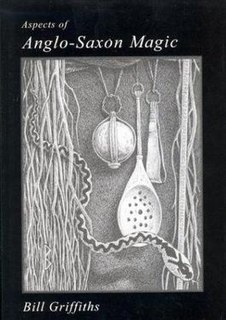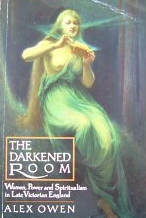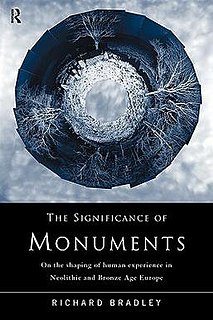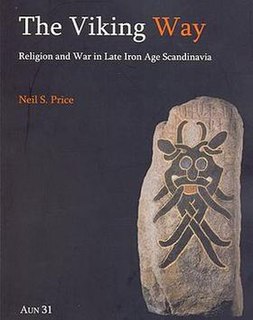 W
WAnglo-Saxon Amulets and Curing Stones is an archaeological study of amulets, talismans and curing stones in the burial record of Anglo-Saxon England. Written by the Australian archaeologist Audrey Meaney, it was published by the company British Archaeological Reports as the 96th monograph in their BAR British Series. Prior to writing the work, Meaney had published several books dealing with Anglo-Saxon burials.
 W
WAnglo-Saxon Deviant Burial Customs is an archaeological study of atypical burial practices in Anglo-Saxon England. It was written by the English archaeologist Andrew Reynolds of the UCL Institute of Archaeology, based on the work which he had undertaken for his PhD, completed in 1998. The book was first published by Oxford University Press in 2009 as a part of their series on "Medieval History and Archaeology", edited by John Blair and Helena Hamerow.
 W
WThe Archaeology of Death and Burial is an archaeological study by the English archaeologist Mike Parker Pearson, then a professor at the University of Sheffield. It was first published in 1999 by Sutton Publishing Limited, and later republished by The History Press.
 W
WThe Archaeology of Hindu Ritual: Temples and the Establishment of the Gods is an archaeological study focusing on the early development of Hinduism within the Gupta Empire between the 4th and 6th centuries CE. Written by the British archaeologist Michael D. Willis, curator of the South Asian and Himalayan collection at the British Museum, it was published by Cambridge University Press in 2009.
 W
WThe Archaeology of Ritual and Magic is an archaeological study of the material evidence for ritual and magical practices in Europe, containing a particular emphasis on London and South East England. It was written by the English archaeologist Ralph Merrifield, the former deputy director of the Museum of London, and first published by B.T. Batsford in 1987.
 W
WThe Archaeology of Shamanism is an academic anthology edited by the English archaeologist Neil Price which was first published by Routledge in 2001. Containing fourteen separate papers produced by various scholars working in the disciplines of archaeology and anthropology, it looks at the manner in which archaeologists can interpret shamanism in the archaeological record.
 W
WAspects of Anglo-Saxon Magic is a study of Anglo-Saxon paganism and the role of magic in Anglo-Saxon England that was written by the English poet and independent scholar Bill Griffiths. It was first published in 1996 by Anglo-Saxon Books, and later republished in a revised edition in 2003.
 W
WBeyond the Witch Trials: Witchcraft and Magic in Enlightenment Europe is an academic anthology edited by the historians Owen Davies and Willem de Blécourt. It was first published by Manchester University Press in 2004. Containing ten separate papers by different academics active in the field, the book dealt with the continued practice of magic and the belief in witchcraft in Europe following the end of the Witch trials in the Early Modern period.
 W
WA Community of Witches: Contemporary Neo-Paganism and Witchcraft in the United States is a sociological study of the Wiccan and wider Pagan community in the Northeastern United States. It was written by American sociologist Helen A. Berger of the West Chester University of Pennsylvania and first published in 1999 by the University of South Carolina Press. It was released as a part of a series of academic books entitled Studies in Comparative Religion, edited by Frederick M. Denny, a religious studies scholar at the University of Chicago.
 W
WThe Darkened Room: Women, Power and Spiritualism in Late Victorian England is a historical study into the role played by women in the Spiritualist religious movement in England during the latter part of the 19th century. It was written by the British historian Alex Owen and first published in 1989 by Virago, before being republished in 2004 by the University of Chicago Press.
 W
WDeath and Memory in Early Medieval Britain is an archaeological study of mnemonic elements in the funerary practices of Early Medieval Britain, written by the British archaeologist Howard Williams. The book was first published by Cambridge University Press as part of their series "Cambridge Studies in Archaeology" in 2006.
 W
WDreamtime: Concerning the Boundary between Wilderness and Civilization is an anthropological and philosophical study of the altered states of consciousness found in shamanism and European witchcraft written by German anthropologist Hans Peter Duerr. First published in 1978 by Syndikat Autoren-und Verlagsgesellschaft under the German title of Traumzeit: Über die Grenze zwischen Wildnis und Zivilisation, it was translated into English by the Hungarian-American anthropologist Felicitas Goodman and published by Basil Blackwell in 1985.
 W
WEurope's Inner Demons: An Enquiry Inspired by the Great Witch-Hunt is a historical study of the beliefs regarding European witchcraft in Late Medieval and Early Modern Europe, with particular reference to the development of the witches' sabbat and its influence on the witch trials in the Early Modern period. It was written by the English historian Norman Cohn, then of the University of Sussex, and first published by Sussex University Press in association with Heinemann Educational Books in 1975. It was released as a part of a series of academic books entitled 'Studies in the Dynamics of Persecution and Extermination' that were funded by the Columbus Centre and edited by Cohn himself.
 W
WGiordano Bruno and the Hermetic Tradition is a 1964 non-fiction book by British historian Frances A. Yates. The book delves into the history of Hermeticism and its influence upon Renaissance philosophy and Giordano Bruno.
 W
WHeathen Gods in Old English Literature is a historical study of the literary references for several pagan deities in Anglo-Saxon England. Written by the English studies scholar Richard North of University College London, it was first published by Cambridge University Press in 1997. The book was released as the twenty-second monograph in the Press' series, "Cambridge Studies in Anglo-Saxon England", edited by Simon Keynes, Michael Lapidge and Andy Orchard. Prior to the book's publication, North had previously authored other studies of Anglo-Saxon paganism, such as Pagan Words and Christian Meanings (1991).
 W
WHer Hidden Children: The Rise of Wicca and Paganism in America is a historical study of Wicca and Contemporary Paganism in the United States. It was written by the American academic Chas S. Clifton of Colorado State University-Pueblo, and published by AltaMira Press in 2005.
 W
WInside the Neolithic Mind: Consciousness, Cosmos and the Realm of the Gods is a cognitive archaeological study of Neolithic religious beliefs in Europe co-written by the archaeologists David Lewis-Williams and David Pearce, both of the University of the Witwatersrand in Johannesburg, South Africa. It was first published by Thames and Hudson in 2005. Following on from Lewis-Williams' earlier work, The Mind in the Cave (2002), the book discusses the role of human cognition in the development of religion and Neolithic art.
 W
WMagic, Witchcraft and the Otherworld: An Anthropology is an anthropological study of contemporary Pagan and ceremonial magic groups that practiced magic in London, England, during the 1990s. It was written by English anthropologist Susan Greenwood based upon her doctoral research undertaken at Goldsmiths' College, a part of the University of London, and first published in 2000 by Berg Publishers.
 W
WThe Man-Eating Myth: Anthropology and Anthropophagy is an influential anthropological study of socially sanctioned cultural cannibalism across the world, which casts a critical perspective on the existence of such practices. It was authored by the American anthropologist William Arens of Stony Brook University, New York, and first published by Oxford University Press in 1979.
 W
WThe Mind in the Cave: Consciousness and the Origins of Art is a 2002 study of Upper Palaeolithic European rock art written by the archaeologist David Lewis-Williams, then a professor at the University of the Witwatersrand in Johannesburg, South Africa.
 W
WThe Pagan Middle Ages is an academic anthology edited by the Belgian historian Ludo J.R. Milis. Containing eight papers by various Dutch and Belgian historians and archaeologists, it is devoted to the study of how various pre-Christian religious beliefs and practices survived and were absorbed into the new, Christian society in Europe during the Middle Ages. It was first published by the Institut Historique Belge de Rome in 1991 under the Dutch title of De Heidense Middeleeuwen and subsequently translated into English by Tanis Guest and published by The Boydell Press in 1998.
 W
WThe Pagan Religions of the Ancient British Isles: Their Nature and Legacy is a book of religious history and archaeology written by the English historian Ronald Hutton, first published by Blackwell in 1991. It was the first published synthesis of the entirety of pre-Christian religion in the British Isles, dealing with the subject during the Palaeolithic, Neolithic, Bronze Age, Iron Age, Roman occupation and Anglo-Saxon period. It then proceeds to make a brief examination of their influence on folklore and contemporary Paganism.
 W
WThe Rise of Magic in Early Medieval Europe is a historical study of magical beliefs in Europe between the 5th and 12th centuries CE. It was written by the English historian Valerie I.J. Flint, then of the University of Auckland, and published by Princeton University Press in 1991.
 W
WRites of the Gods is an archaeological study of religious belief and ritual practices across prehistoric Britain from the Old Stone Age through to the Iron Age. Written by the prominent English archaeologist and megalithic specialist Aubrey Burl, it was first published in 1981 by J.M. Dent & Sons Ltd.
 W
WRitual and Domestic Life in Prehistoric Europe is a book by the English archaeologist Richard Bradley of the University of Reading. It was first published by Routledge in 2005.
 W
WRock Art and the Prehistory of Atlantic Europe: Signing the Land is an archaeological book authored by the English academic Richard Bradley of the University of Reading. It was first published by Routledge in 1997.
 W
WShamanism: Archaic Techniques of Ecstasy is a historical study of the different forms of shamanism around the world written by the Romanian historian of religion Mircea Eliade. It was first published in France by Librarie Payot under the French title of Le Chamanisme et les techniques archaïques de l'extase in 1951. The book was subsequently translated into English by Willard R. Trask and published by Princeton University Press in 1964.
 W
WShamans: Siberian Spirituality and the Western Imagination is a historical study of how westerners have viewed the shamans of Siberia. It was written by the English historian Ronald Hutton, then working at the University of Bristol, and first published by Hambledon and London in 2001. Prior to writing Shamans, Hutton had authored a series of books on such subjects as Early Modern Britain, pre-Christian religion, British folklore and Contemporary Paganism.
 W
WSignals of Belief in Early England: Anglo-Saxon Paganism Revisited is an academic anthology edited by the British archaeologists Martin Carver, Alex Sanmark and Sarah Semple which was first published by Oxbow Books in 2010. Containing nine separate papers produced by various scholars working in the fields of Anglo-Saxon archaeology and Anglo-Saxon history, the book presents a number of new perspectives on Anglo-Saxon paganism and, to a lesser extent, early Anglo-Saxon Christianity. The collection – published in honour of the archaeologist Audrey Meaney – was put together on the basis of a conference on "Paganism and Popular Practice" held at the University of Oxford in 2005.
 W
WThe Significance of Monuments: On the Shaping of Human Experience in Neolithic and Bronze Age Europe is an archaeological book authored by the English academic Richard Bradley of the University of Reading. It was first published by Routledge in 1998.
 W
WSome Spirits Heal, Others Only Dance: A Journey into Human Selfhood in an African Village is an anthropological study of the ngulu cult among the Lungu people of Zambia authored by the anthropologist Roy Willis. It was first published in 1999 by Berg Publishers.
 W
WThe Tribe of Witches: The Religion of the Dobunni and Hwicce is a historical and archaeological study of pre-Christian religion among the Iron Age Dobunni and the Early Medieval Hwicce, two tribal groups who lived in central England. It was written by the archaeologist Stephen J. Yeates and published by Oxbow Books in 2008. Yeates had previously published his theories in a three-volume British Archaeological Report monograph entitled Religion, Community and Territory: Defining Religion in the Severn Valley and Adjacent Hills from the Iron Age to the Early Medieval Period (2006).
 W
WThe Triumph of the Moon: A History of Modern Pagan Witchcraft is a book of religious history by the English historian Ronald Hutton, first published by Oxford University Press in 1999. At the time, Hutton was a Reader in History at Bristol University, and had previously published a study of ancient pre-Christian religion, The Pagan Religions of the Ancient British Isles (1991) as well as studies of British folk customs and the Early Modern period.
 W
WThe Viking Way: Religion and War in Late Iron Age Scandinavia is an archaeological study of Norse paganism in Late Iron Age-Scandinavia. It was written by the English archaeologist Neil Price, then a professor at the University of Aberdeen, and first published by the Department of Archaeology and Ancient History at Uppsala University in 2002. A revised second edition is due to be published in 2017 by Oxbow Books.
 W
WWitchcraft and Paganism in Australia is an anthropological study of the Wiccan and wider Pagan community in Australia. It was written by the Australian anthropologist Lynne Hume and first published in 1997 by Melbourne University Press.